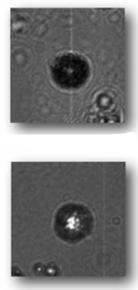Current cell culture models using very thin sections (2D) and conventional
imaging methods both have their limitations. For example, confocal microscopy
requires fixing, labeling and imaging cells in ‘z’ (depth) to study their 3D
structure. These classic approaches, which are time-consuming and limited in
their fields of view, do not allow the study of developmental dynamics in 3D
of an epithelial tissue, such as from secretory glands (prostate, breast,
salivary gland, lung, etc.).
 Lensless imaging. Top: healthy cell line. Bottom: cancer cell line. | In Grenoble, a team from the CEA-iRTSV, in collaboration with the CEA-Leti, has
developed an innovative methodology coupling “lensless” imaging with 3D cell
culture. This technique was tested on epithelial cells from healthy
prostates, and on tumor line cells. After 6 days of culture, the biologists
observed a signature that is characteristic of healthy cells and tumor
cells, which do not organize the same way in 3D. They have succeeded to discriminate and count them by comparing the “lensless”
optical signature from the two types of structures, and by applying holographic
reconstruction algorithms. P |
laced in an incubator, the very compact imaging
device offers a wide field of vision, which enables tracking the evolution of 3D
structures over several days and assessing their fate in response to a change in
culture conditions.
The 3D culture/“lensless” coupling opens up new possibilities for the study of
cell-cell and cell-microenvironment interactions. This method could meet the
needs of the pharmaceutical industry for new 3D screening tools that are
both more physiologically relevant than current high-throughput screening
systems, and which allow the selection of more effective therapeutic molecules
(through an improved assessment of their toxicity).